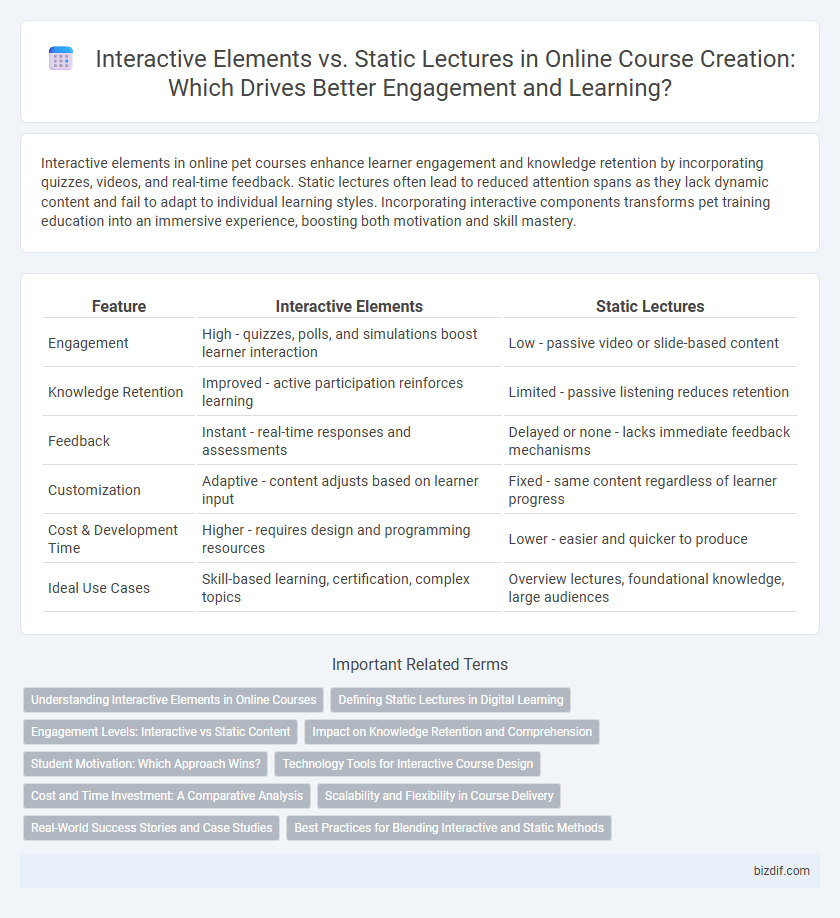Interactive elements in online pet courses enhance learner engagement and knowledge retention by incorporating quizzes, videos, and real-time feedback. Static lectures often lead to reduced attention spans as they lack dynamic content and fail to adapt to individual learning styles. Incorporating interactive components transforms pet training education into an immersive experience, boosting both motivation and skill mastery.
Table of Comparison
| Feature | Interactive Elements | Static Lectures |
|---|---|---|
| Engagement | High - quizzes, polls, and simulations boost learner interaction | Low - passive video or slide-based content |
| Knowledge Retention | Improved - active participation reinforces learning | Limited - passive listening reduces retention |
| Feedback | Instant - real-time responses and assessments | Delayed or none - lacks immediate feedback mechanisms |
| Customization | Adaptive - content adjusts based on learner input | Fixed - same content regardless of learner progress |
| Cost & Development Time | Higher - requires design and programming resources | Lower - easier and quicker to produce |
| Ideal Use Cases | Skill-based learning, certification, complex topics | Overview lectures, foundational knowledge, large audiences |
Understanding Interactive Elements in Online Courses
Interactive elements in online courses enhance learner engagement by incorporating quizzes, polls, and simulations that promote active participation and real-time feedback. Unlike static lectures, which rely solely on passive video or text delivery, interactive features foster deeper comprehension and retention by encouraging learners to apply concepts and assess their knowledge continuously. Implementing interactive components leads to improved learner motivation and better educational outcomes in digital learning environments.
Defining Static Lectures in Digital Learning
Static lectures in digital learning consist of pre-recorded video or audio content delivered without real-time interaction or engagement features. These lectures typically present information linearly, offering limited opportunities for student participation or immediate feedback. As a result, static lectures may reduce learner retention and motivation compared to interactive elements that actively involve learners through quizzes, discussions, and multimedia activities.
Engagement Levels: Interactive vs Static Content
Interactive elements in online course creation significantly boost engagement levels by promoting active learner participation, such as quizzes, simulations, and discussion forums, which foster better knowledge retention and real-time feedback. Static lectures, characterized by passive content delivery through video or slide presentations, often result in lower learner involvement and reduced motivation due to limited interaction opportunities. Incorporating interactive content directly correlates with increased completion rates and improved learner satisfaction within digital education environments.
Impact on Knowledge Retention and Comprehension
Interactive elements in online course creation, such as quizzes, simulations, and discussion forums, significantly enhance knowledge retention and comprehension by engaging learners actively with the material. Static lectures, often limited to video or text presentations, tend to result in passive learning, which may decrease long-term information recall and understanding. Research indicates that incorporating interactive content increases learner engagement by up to 60%, directly improving cognitive processing and mastery of complex topics.
Student Motivation: Which Approach Wins?
Interactive elements significantly boost student motivation by fostering active participation and immediate feedback, which enhances engagement and knowledge retention. Static lectures often result in passive learning, causing diminished attention and lower enthusiasm among students. Research shows that courses incorporating quizzes, discussion forums, and multimedia content increase motivation and completion rates compared to traditional lecture-based formats.
Technology Tools for Interactive Course Design
Technology tools for interactive course design, such as H5P and Articulate Storyline, enable embedding quizzes, drag-and-drop activities, and multimedia to enhance learner engagement. Unlike static lectures, these tools facilitate real-time feedback and adaptive learning paths, improving knowledge retention and motivation. Integrating video annotations and interactive simulations further transforms traditional content into dynamic, participatory experiences.
Cost and Time Investment: A Comparative Analysis
Interactive elements in online course creation require higher initial cost and longer development time due to the need for multimedia production, programming, and user experience design. Static lectures often demand less investment, relying on pre-recorded videos or slide presentations that are quicker and cheaper to produce. Over time, interactive content may offer better learner engagement and retention, potentially justifying the upfront costs through improved course effectiveness and reduced need for repeated content updates.
Scalability and Flexibility in Course Delivery
Interactive elements in online course creation enhance scalability by accommodating diverse learning styles and increasing student engagement through dynamic content such as quizzes, discussions, and real-time feedback. Static lectures, while easier to produce and distribute, often lack the flexibility to adapt to individual learner needs or update content rapidly, limiting their long-term effectiveness. Prioritizing interactive elements enables scalable course delivery that remains flexible and responsive to evolving educational demands.
Real-World Success Stories and Case Studies
Interactive elements in online course creation significantly enhance learner engagement by incorporating real-world success stories and case studies, which provide practical applications and contextual understanding. Embedding scenarios, quizzes, and problem-solving tasks based on actual business cases increases knowledge retention and motivates learners through relatable examples. Static lectures often lack this dynamic interaction, making them less effective in demonstrating the tangible impact of course material on real-life outcomes.
Best Practices for Blending Interactive and Static Methods
Blending interactive elements such as quizzes, polls, and discussion forums with static lectures enhances learner engagement and knowledge retention by catering to diverse learning styles. Best practices emphasize balancing concise video lectures with active learning tasks, ensuring content clarity while promoting critical thinking and real-time feedback. Incorporating multimedia tools like simulations alongside traditional slides creates a dynamic learning environment that maximizes course effectiveness and student satisfaction.
Interactive elements vs Static lectures Infographic

 bizdif.com
bizdif.com